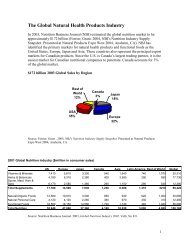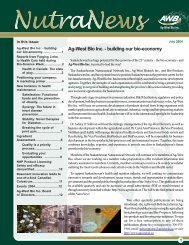Beyond Borders: Global biotechnology report 2010
Beyond Borders: Global biotechnology report 2010
Beyond Borders: Global biotechnology report 2010
You also want an ePaper? Increase the reach of your titles
YUMPU automatically turns print PDFs into web optimized ePapers that Google loves.
with Elan (the judge agreed) the parties<br />
renegotiated the deal to remove the<br />
side agreement and reduce the equity<br />
investment by US$115 million. Biogen<br />
Idec didn’t like the side agreement in part<br />
because it could discourage other<br />
potential acquirers.<br />
Sharing the risk<br />
With biotech companies and their investors<br />
needing to secure financing or find exits in<br />
a challenging environment, the bargaining<br />
power in deals swung toward buyers in<br />
2008 and remained there in 2009. With<br />
this shift came an increase in various forms<br />
of “risk sharing” arrangements that gave<br />
biotech companies more risk than they<br />
would have assumed in years past.<br />
On the M&A front, risk-sharing manifested<br />
itself in the increasing number of<br />
transactions that included milestone<br />
payments (sometimes referred to as<br />
contingent value rights or CVRs). This<br />
was most common in takeouts of private<br />
companies, including sanofi-aventis’<br />
acquisition of BiPar Sciences for up<br />
to US$500 million (including US$125<br />
million of milestones), Alcon’s acquisition<br />
of ESBATech for up to US$589 million<br />
(including US$439 million of milestones),<br />
and Novartis’ acquisition of Cothera for a<br />
potential value of US$620 million (including<br />
US$500 million of milestones).<br />
Biotech buyers also used the CVR structure<br />
commonly during 2009, in part to bridge<br />
differences in perceived value. The more<br />
significant biotech-biotech deals with<br />
CVRs included Onyx Pharmaceuticals’<br />
takeout of Proteolix for a potential value<br />
of US$851 million (including US$575<br />
million of potential milestones), Celgene’s<br />
acquisition of Gloucester Pharmaceuticals<br />
for a potential value of US$640 million<br />
(including US$300 million of milestones)<br />
and Cubist Pharmaceuticals’ acquisition<br />
of Calixa for US$403 million (including<br />
US$310 million of milestones). The<br />
CVR structure was not limited to private<br />
companies either, as both The Medicine<br />
Company’s acquisition of publicly<br />
traded Targanta Therapeutics and Endo<br />
Pharmaceuticals’ takeout of publicly<br />
traded Indevus Pharmaceuticals included<br />
such rights. CombinatoRx and NeuroMed<br />
of Canada forged a particularly creative<br />
contingent transaction. The two parties<br />
struck a merger agreement which had<br />
shareholders of each company initially<br />
holding 50% of the combined entity.<br />
However, much of the value of NeuroMed<br />
was tied to receiving FDA approval to<br />
market Exalgo, a drug for the treatment of<br />
chronic pain. The two parties agreed that<br />
if Exalgo was approved by a specified date,<br />
the ownership percentage would adjust<br />
in the favor of NeuroMed’s shareholders.<br />
This scenario came to pass when the drug<br />
was approved by the FDA in March <strong>2010</strong>.<br />
CombinatoRx issued additional shares<br />
to the former NeuroMed shareholders<br />
equaling an additional 10% of the combined<br />
company. The approval also triggered a<br />
US$40 million milestone payment from<br />
Covidien, which will market the drug.<br />
While contingent rights serve a valid<br />
business purpose, they can create deal<br />
and asset valuation issues for the acquirer,<br />
both at closing and in subsequent <strong>report</strong>ing<br />
periods. (For more information, see A closer<br />
look on the previous page.)<br />
Having options<br />
The use of option structures in biotech deals<br />
has been around for awhile. In early 2007,<br />
for instance, Amgen paid Cytokinetics<br />
US$75 million for an option to license<br />
a cardiovascular drug candidate (the<br />
company exercised the option in 2009 for<br />
80 <strong>Beyond</strong> borders <strong>Global</strong> <strong>biotechnology</strong> <strong>report</strong> <strong>2010</strong><br />
an additional US$50 million). In the current<br />
environment, however, such structures are<br />
becoming increasingly common.<br />
In these arrangements, the buyer pays a<br />
fee (and in some cases makes an equity<br />
investment) in exchange for the right<br />
to license a particular product at a later<br />
date (e.g., upon successful completion<br />
of a clinical trial). The biotech company<br />
typically uses the proceeds from the<br />
option transaction to further the product’s<br />
development. Early in the year, Cephalon<br />
and privately held Ception announced<br />
an option-based acquisition structure<br />
under which Cephalon paid US$100<br />
million (a portion of which was returned<br />
to Ception’s venture capital investors)<br />
for an option to acquire the company for<br />
an additional US$250 million following<br />
the results of a key clinical trial. In early<br />
<strong>2010</strong>, Cephalon exercised the option.<br />
Cephalon also used this structure in a deal<br />
with BioAssets, and Novartis employed<br />
acquisition options in deals with Proteon<br />
and Elixir Pharmacuticals, each of which<br />
has a potential acquisition price in excess of<br />
US$500 million.<br />
Of course, option structures are not<br />
limited to M&As; they can also be used in<br />
licensing transactions involving individual<br />
R&D programs. GlaxoSmithKline has<br />
been the most prominent user of option<br />
structures in such deals; in 2009 alone the<br />
company entered transactions that included<br />
option rights with Vernalis, Prosensa,<br />
Chroma Therapeutics, Supergen, Concert<br />
Pharmaceuticals and others. Buyers may<br />
end up paying more for a product that<br />
achieves the desired clinical outcome and<br />
is later licensed through the exercise of the<br />
option. However, over a portfolio of deals,<br />
they manage the risk of failure by having<br />
multiple “shots on goal” and only paying<br />
to license products that have successfully<br />
reached the desired outcome. When GSK








